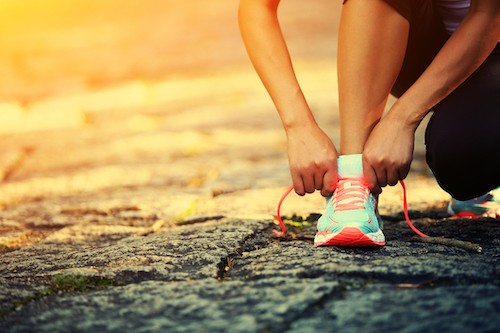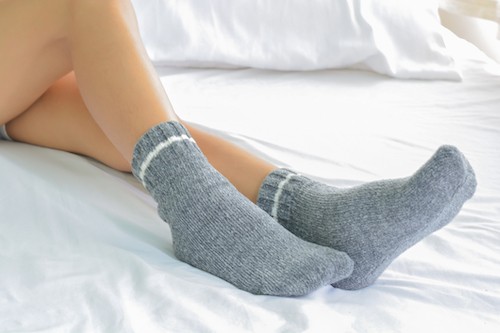There’s a good chance your doctor has recommended walking as a way to manage your mild to moderate varicose vein symptoms. This is good advice since walking is widely regarded as one of the best forms of self-care for varicose vein sufferers.
But walking offers much more! In addition to helping alleviate varicose vein symptoms, walking provides so many benefits to your health that we thought it would be useful to list a few of them for you here. As you walk away your varicose vein discomfort, we hope you will enjoy knowing about these wonderful health benefits in store for you just by taking your daily stride.
1. Burn Calories and Help You Maintain a Healthy Weight
You may be pleasantly surprised at how many calories you can burn from moderate-paced walking. This online calorie calculator will determine your calorie burn rate based on a few parameters that you enter. For optimal health benefits, it’s good to aim for at least 30 minutes per day and you can break up your thirty minutes into, say, three 10-minute sessions spaced throughout the day. If you’re a numbers person you can wear a pedometer that will count your steps. Check with your doctor to determine your best starting and goal numbers for minutes or steps.

2. Improve Circulation
Walking is one of the best ways to improve your overall circulation and especially the circulation in your legs since it is a gravity dependent activity that mostly uses your legs. Aside from helping reduce your varicose vein symptoms regular walking can lower your blood pressure in both your arteries and your veins. And it strengthens your heart!
3. Improve Mood
Having a chronic health condition like varicose veins can be as emotionally stressful as it is physically debilitating, causing some people to become anxious or depressed. Walking has been shown to substantially improve symptoms of depression, anxiety, low self-esteem, psychological stress, and social isolation and loneliness[1].
4. Aid Digestion
The slight rotational motion of walking gently massages your intestines. This assists digestion in numerous ways and can even improve symptoms in some challenging digestive conditions. A study of the effects of walking for patients with mild irritable bowel syndrome (IBS) reported that the more the participants walked each day the more likely they were to experience symptom improvement[2]. Pro tip: to derive the most digestive benefits schedule your walks after your meals.
5. Boost Immunity
As you age your immune function gradually declines and exercise is known to bolster immune function in older people. Cardiovascular exercise, such as walking, has been shown to increase the effectiveness of the flu vaccine in older adults, reducing illness severity and extending flu protection throughout the entire flu season[3].
6. Improve Sleep
When you burn excess calories and give your muscles and cardiovascular system a healthy workout you will most likely enjoy better quality sleep. A study of menopausal women (and who has more trouble sleeping than this group!) had participants wear pedometers and increase their walking distance by 500 steps per week. After just 12 weeks the participants reported significant improvement in sleep quality and duration and shorter time to fall asleep[4].

7. Prevent and Manage Chronic Health Conditions
Chronic conditions such as heart disease, high blood pressure, and type 2 diabetes are widespread in the U.S. and other industrialized countries around the world. These are commonly grouped into a category known as metabolic syndrome. Regular walking lowers your cholesterol levels, improves your blood sugar levels, and lowers your blood pressure and has been found to reduce the risk for metabolic syndrome by more than 4x[5].
8. Strengthen Bones and Muscles
If osteoporosis is a concern for you then walking is high on your must-do list. Walking is one of the best exercises known to slow bone loss. And, by adding some strengthening and resistance exercises to your walking routine, such as light weight lifting or resistance bands and balance training you can even build back some lost bone mass[6].
9. Ease Joint Pain
For those with mild to moderate osteoarthritis, adhering to a regular walking program can improve joint function and reduce joint pain[7]. Walking builds muscle strength and stronger muscles are better able to absorb the impact of walking, taking stress off the joints.
10. Turn Your Walking Game Up a Notch By Walking Backwards!
If you’re already pretty good at walking forwards and looking for a challenge, consider walking backwards. Short 10-minute sessions 3 days per week have been shown to be especially helpful at reducing joint pain and improving muscle strength in older individuals with mild to moderate osteoarthritis[8]. And backwards steps count on your pedometer! For safety, backwards walking should be done with the supervision of a trainer or physical therapist.
11. Improve Balance and Coordination
Walking activates your brain’s proprioception mechanisms – the sense of where your body is in space. As an illustration of how important walking is to maintaining balance and coordination, think of how much effort and concentration a baby expends to achieve his or her first tottering steps. Though walking quickly becomes second nature and your first steps will likely be the most auspicious ones of your life, walking continues to be a great way to keep your proprioception sense strong.

As a reminder, if your varicose veins are progressing or causing you pain that interferes with your work and enjoyment of life, you have options. You can reduce or eliminate leg pain by having your veins treated by a qualified vascular surgeon. Most procedures are performed in-office and have fast healing times. You may even be able to walk out of the clinic after your procedure!
To learn about which vein treatment is right for you we invite you to schedule a free consultation at Empire Vein & Vascular Specialists. All of our physicians are board-certified vascular surgeons who specialize in helping people like you.
Empire Vein & Vascular Specialists is the top provider of VenaSeal™, the leading outpatient varicose vein treatment, in the USA. Schedule a free consultation today by calling 1-800-827-4267 (1-800-827-4267).
References
- Walking on sunshine: scoping review of the evidence for walking and mental health. Br J Sports Med, 2018. 52(12): p. 800-806
https://pubmed.ncbi.nlm.nih.gov/29858467 - The effects of locomotor activity on gastrointestinal symptoms of irritable bowel syndrome among younger people: An observational study. PLoS One, 2020. 15(5): p. e0234089
https://pubmed.ncbi.nlm.nih.gov/32470098 - Cardiovascular exercise training extends influenza vaccine seroprotection in sedentary older adults: the immune function intervention trial. J Am Geriatr Soc, 2009. 57(12): p. 2183-91
https://pubmed.ncbi.nlm.nih.gov/20121985 - Impact of pedometer-based walking on menopausal women’s sleep quality: a randomized controlled trial. Climacteric, 2016. 19(4): p. 364-8
https://pubmed.ncbi.nlm.nih.gov/26757356 - Association of regular walking and body mass index on metabolic syndrome among an elderly Korean population. Exp Gerontol, 2018. 106: p. 178-182
https://pubmed.ncbi.nlm.nih.gov/29522861 - The Effectiveness of Physical Exercise on Bone Density in Osteoporotic Patients. Biomed Res Int, 2018. 2018: p. 4840531
https://pubmed.ncbi.nlm.nih.gov/30671455 - Effects of exercise adherence on physical function among overweight older adults with knee osteoarthritis. Arthritis Rheum, 2005. 53(1): p. 24-32
https://pubmed.ncbi.nlm.nih.gov/15696558 - Effect of 6-week retro or forward walking program on pain, functional disability, quadriceps muscle strength, and performance in individuals with knee osteoarthritis: a randomized controlled trial (retro-walking trial). BMC Musculoskelet Disord, 2019. 20(1): p. 159
https://pubmed.ncbi.nlm.nih.gov/30967128